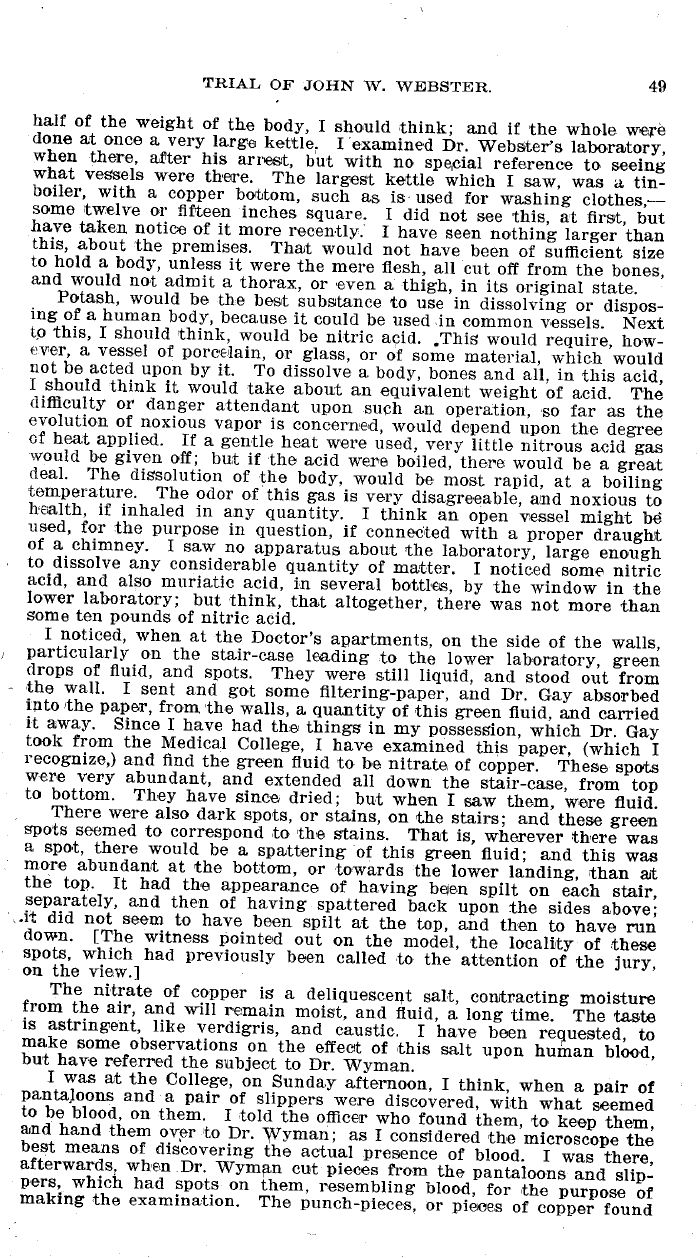|
TRIAL OF JOHN W. WEBSTER. 49
half of the weight of the body, I should think; and if the whole were
done at once a very large kettle. 1 'examined Dr. Webster's laboratory,
when there, after his arrest but with no special reference to seeing
what vessels were theme. The largest kettle which I saw, was a tin-
boiler, with a copper bottom, such as is used for washing clothes,-
some twelve or fifteen inches square. I did not see this, at first, but
have taken notice of it more recently: I have seen nothing larger than
this, about the premises. That would not have been of sufficient size
to hold a body, unless it were the mere flesh, all cut off from the bones,
and would not admit a thorax, or -even a thigh, in its original state.
Potash, would be the best substance to use in dissolving or dispos-
ing of a human body, because it could be used in common vessels. Next
to this, I should think, would be nitric acid. .This would require, how-
ever, a vessel of porclain or glass, or of some material, which would
not be acted upon by it. To dissolve a body, bones and all, in this acid,
I should think it would take about an equivalent weight of acid. The
difficulty or danger attendant upon such an operation, so far as the
evolution of noxious vapor is concerned, would depend upon the degree
of heat applied. If a gentle heat were used, very little nitrous acid gas
would be given off ; but if the acid were boiled, there would be a great
deal. The dissolution of the body, would be most rapid, at a boiling
temperature. The odor of this gas is very disagreeable, and noxious to
health if inhaled in any quantity. I think an open vessel might be
used, for the purpose in question, if connected with a proper draught
of a chimney. I saw no apparatus about the laboratory, large enough
to dissolve any considerable quantity of matter. I noticed some nitric
acid, and also muriatic acid, in several bottles, by the window in the
lower laboratory; but think, that altogether, there was not more than
some ten pounds of nitric acid.
I noticed, when at the Doctor's apartments, on the side of the walls,
particularly on the stair-case leading to the lower laboratory, green
drops of fluid, and spots. They were still liquid, and stood out from
the wall. I sent and got some filtering-paper, and Dr. Gay absorbed
into the paper, from the walls, a quantity of this green fluid, and carried
it away. Since I have had the, things in my possession, which Dr. Gay
took from the Medical College, I have examined this paper, (which I
recognize,) and find the green fluid to be nitrate of copper. These spots
were very abundant, and extended all down the stair-case, from top
to bottom. They have since dried; but when I saw them, were fluid.
There were also dark spots, or stains, on the stairs and these green
spots seemed to correspond to the stains. That is, wherever there was
a spot, there would be a spattering of this green fluid; and this was
more abundant at the bottom, or towards the lower landing, than at
the top. It had the appearance of having been spilt on each stair,
separately, and then of having spattered back upon the sides above;
it did not seem to have been spilt at the top, and then to have run
down. [The witness pointed out on the model, the locality of these
spots, which had previously been called to the attention of the jury,
on the view.]
The nitrate of copper is a deliquescent salt, contracting moisture
from the air, and will remain moist, and fluid, a long time. The taste
is astringent like verdigris and caustic. I have been requested, to
make some observations on the effect of this salt upon human blood,
but have referred the subject to Dr. Wyman.
I was at the College, on Sunday afternoon, I think, when a pair of
pantaloons and a pair of slippers were discovered, with what seemed
to be blood, on them. I told the officer who found them, to keep them,
and hand them over to Dr. Wyman; as I considered the microscope the
best means of discovering the actual presence of blood. I was there,
afterwards, when Dr. Wyman cut pieces from the pantaloons and slip-
pers, which had spots on them, resembling blood, for the purpose of
making the examination. The punch-pieces, or pieces of copper found
|

